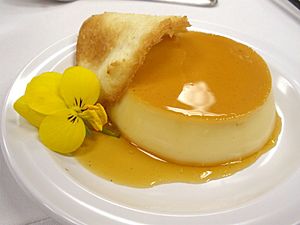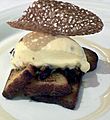Tuile facts for kids

A tuile arced over a creme caramel dessert
|
|
| Type | Cookie or wafer |
|---|---|
| Place of origin | France |
| Main ingredients | Flour, white sugar, butter, and almonds |
A tuile is a thin, crispy cookie from France. It is usually curved, like the roof tiles found on old French houses. In fact, "tuile" is the French word for "tile"!
Tuiles are often served with other foods. They can be a crunchy side to desserts like panna cotta. Sometimes, they are even shaped into little cups to hold sorbet or ice cream.
Making Tuiles: A Sweet Treat
Tuiles are very thin cookies. They get their name and curved shape from the tuiles, or tiles, on French rooftops. These are especially common in the Provence region of France.
To make them curved, tuiles are shaped while they are still warm. Bakers often drape them over a rolling pin or a wine bottle. If you wait for them to cool, they will become stiff and break. You can also leave tuiles flat if you prefer.
The basic recipe for tuiles uses flour, white sugar, melted butter, and almonds. Today, people make many different kinds of tuiles with various flavors and ingredients.
Tuile Pictures
-
A simple bread tuile served with foie gras.
-
A cinnamon tuile over French toast and bacon ice cream.
-
A honey tuile over cups containing a sweetened cream, ginger panna cotta.
See also
 In Spanish: Tuile para niños
In Spanish: Tuile para niños




